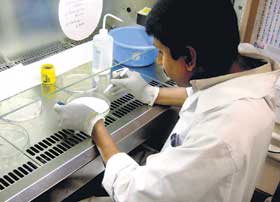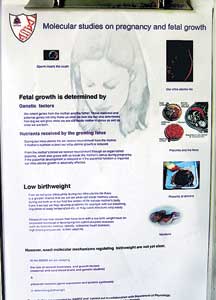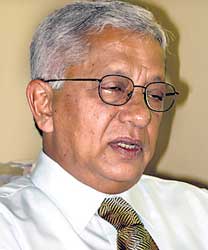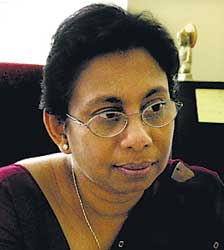
Seeking answers in moleculesNeed a paddy strain which can resist salinity in the soil, a variety which will withstand a drought and not leave the farmers wringing their hands in despair or a disease-resistant kind to bring a bountiful harvest and ease the burden of consumers in times when rice prices have sky-rocketed. What of the other major crops in the country - tea and rubber bringing in all-important foreign exchange and coconut, also so pricey these days, essential for that hot pol-sambol? The nightmare of any developing country such as ours is a blight or pest, which could affect these crops with the coconut beetle still sending tremors through the industry.
Like in the developed world, the need is research and Sri Lanka-specific research. And in white coats, either peering into microscopes or mixing substances at work-stations, using cutting-edge technology, a silent service is being rendered by young men and women drawn from across the country to the Institute of Biochemistry, Molecular Biology and Biotechnology (IBMBB) located amidst the bustling university complex on Thurstan Road. Jaw-breaking the name may be, but the IBMBB has two simple but vital objectives as explained by Founder Director Prof. Eric H. Karunanayake. To undertake research work in areas connected to the development of the country, while producing human resources such as many with Master's and Ph.Ds in biotechnology-related fields. Lamenting that Sri Lanka has no "critical mass" qualified in molecular life sciences, he says, "We won't achieve industrialization unless we have highly-trained scientists who will use technology as a tool." Current Director Prof. Kamani Tennekoon spells out the research programmes undertaken by IBMBB in both fields of plant and human molecular biology. Citing some examples, Prof. Tennekoon says the IBMBB is developing a method to identify rubber plants resistant to Corynespora Leaf Fall, considered the most destructive leaf disease of rubber in both Asia and Africa. "The control of this disease is development of resistant clones and experiments are in progress to characterize a DNA fragment which is specific for the resistant clones," she says. With regard to rice production, Prof. Tennekoon says although new improved varieties developed using foreign rice varieties are popular for their high yields, there is an increasing demand for the export of traditional rice varieties as the grain quality including fibre content is high. Therefore, the genetic diversity of these traditional varieties is are being analyzed in addition to screening for disease-resistance, she discloses, while identification of salt-tolerant genes is also underway. Saline soil is intolerable to most plants, robbing them of nutrients and dehydrating them causing 'salt stress'. Pointing to that all-important export crop of tea, the Director says that a scientist of the Tea Research Institute is carrying out genetic studies on tea as part of his Ph.D thesis at the institute. "Field assessment of blister blight disease to identify immune/highly resistant and susceptible plants is in progress at the IBMBB," says Prof. Tennekoon, adding that a paper presented at the 3rd International Conference on O-CHA (Tea) Culture and Science at the University of Shizuoka, Japan by him was selected as the best 'Researcher Award'.
From tea to coconut, in 2002, the IBMBB had determined, using the molecular method, that the coconut germ plasm in Sri Lanka can no longer be improved as it has been cross-bred many times, with the industry being advised to get new germ plasm from abroad to mix with the local plasm. A threat to the sugarcane industry in the country, phytoplasma disease, has been found to be linked to the white-leaf disease due to the diligence of an M.Phil student who had also found that little leaf disease in brinjal and phyllody in sesame plants were also caused by phytoplasma. Other groundbreaking studies being carried out are altering the fatty acid profile, through hybridization with canola, of mustard varieties found in Sri Lanka to prevent heart disease; identification of the active components in three medicinal plants Nika (Vitex negundo), Araththa (Alpinia calcarata) and Rathmal (Ixora coccinea); and preliminary work to develop a research programme on anti-cancer effects of medicinal plants. "Reported anti-inflammatory activity of Nika, Araththa and Rathmal has been confirmed. Experiments are on to isolate the chemical compounds responsible which in turn could lead to medicines being developed from these," says Prof. Tennekoon, as regular anti-inflammatory drugs such as non-steroids may have dangerous side-effects. The IBMBB is also checking out whether other medicinal plants could be a source for new anti-malarial drugs, in the light of problems such as increasing drug resistance and high costs of drugs already available. "We are evaluating both the anti-parasitic (killing the parasite) and anti-disease (reducing symptoms) effects of five medicinal plants," she said. Much ground covered and many ventures undertaken, the IBMBB had its origins as a small molecular biology laboratory in 1988 at the Faculty of Medicine, University of Colombo, supported by the Swedish Agency for Research Cooperation with Developing Countries (SAREC) and the University of Uppsala, Sweden. By the early 1990s, M.Sc and Ph.D students had been enrolled and the earlier direction of research which was mainly on tropical parasitic diseases, expanded to include biomedical research as well as plant molecular biology in collaboration with the Tea, Rubber and Coconut Research Institutes, according to a publication titled, 'Two decades of capacity building in molecular sciences in Sri Lanka: A personal account'. With time, as the programme took off successfully, Prof. Karunanayake says, a new building was required as there was no room for expansion. That was when the Swedish International Development Agency (SIDA), formed by the merging of SAREC and several other units, provided a soft loan of Swedish Kroners 15 million, to expand the research project. "This was the first time that SIDA invested in science and technology infrastructure development in any developing country," he says.
The state-of-the-art Institute of Biochemistry, Molecular Biology and Biotechnology was thus born in 2004. Explaining that molecular techniques are the same in medical science and agriculture, Prof. Karunanayake says all projects undertaken at the IBMBB are of high national relevance while training a mass of scientists. "Students who go abroad for studies in molecular life sciences spend huge sums of foreign exchange while they may never return to Sri Lanka. At this institute, we have the expertise and facilities which these students can access at maybe one-fourth of the cost." The funds to sustain the institute are generated from local and international funding agencies, but the authorities must take note that though the private sector may be the engine of growth, without science and technology it would be an engine without petrol, he says. Taking Sri Lanka's vast marine resources, which Prof. Karunanayake, points out remain untouched, he says strengthening science and technology would help check out marine fungi, marine organisms, mineral content etc for the country's benefit. "Now only 0.18 of the GDP is earmarked for science and technology. We must spend at least .3% and see the tremendous impact." And the impact is already being felt with research carried out by the IBMBB not gathering dust on shelves but being used in the spheres of plant and human life. To the fore to fight disease In a major foray into the wide and fearful world of humans and disease, the IBMBB is attempting to develop a meaningful genetic screening tool for breast cancer in Sri Lanka. Of all cancers, breast cancer is the most common form in women around the world including this country. "Cancer is a genetic disease, arising from an accumulation of alterations (mutations) in the genes of an individual. About 1% of all cancers arise in individuals with a recognizable family history (hereditary cancer condition) who carry a particular familial (germline) mutation in every cell of their body. Although rare, the inherited cancer conditions are of vast biological importance. If common mutations among Sri Lankans are known then screening programmes which are cost effective can be developed," explains Prof. Tennekoon. Stressing that the presence of a mutation does not necessarily mean that an affected individual will develop cancer or the absence not a 100% guarantee that the individual will not develop cancer, she says that those who have mutations in cancer predisposing genes can undergo frequent screening. In the event a cancer develops that can be detected very early and treated. Taking into consideration the fact that low-birth weight predisposes a person to develop non-communicable diseases such as diabetes, hypertension and coronary heart disease in later life, the IBMBB is looking at possible variations in genes that determine foetal growth and also at proteins produced by the placenta to identify which of these are associated with low birth weight. The other human disease field that IBMBB has tackled is filariasis, specifically targeting lymphatic filariasis caused by Wuchereria bancrofti. "As W. bancrofti cannot be cultured our labs have used Setaria digitata, a related filarial parasite found in the peritoneal cavity of cattle as a model organism to study the molecular biology of filarial parasites," says Prof. Tennekoon. The outcome is the construction of a Genomic library and cDNA library of this parasite. Who are we? Where have we come from? Do we carry Eve's mitochondria and Adam's Y chromosome? Scientists have used a region known as the D-loop in mitochondria (the powerhouses of any living cell) to trace ancestral origin and migration of original populations, says Prof. Karunanayake, stressing the importance of development of molecular studies. Mitochondrial DNA is inherited only from the mother and the Y chromosome which determines maleness from the father. "The study of the mitochondrial genome is a useful tool in evolutionary study and in forensic case work especially where samples are degraded and for investigating mitochondrial diseases and biodiversity," he says, adding that preliminary work to establish a database of mitochondrial D loop sequences has been done at IBMBB. Going back to Adam and Eve, he says that international studies have led to strong evidence towards the Out-of-Africa hypothesis. "An interesting question is whether the Garden of Eden was in Africa," he smiles. |
|
||||||
|| Front
Page | News | Editorial | Columns | Sports | Plus | Financial
Times | International | Mirror | TV
Times | Funday
Times || |
| |
Reproduction of articles permitted when used without any alterations to contents and a link to the source page.
|
© Copyright
2008 | Wijeya
Newspapers Ltd.Colombo. Sri Lanka. All Rights Reserved. |



